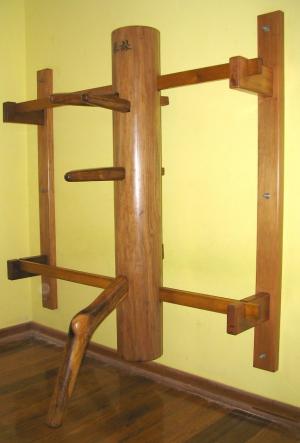The Muk Yan Jong (木人樁; pinyin: mùrénzhuāng; Yale Cantonese: muk6 yan4 jong1; literally “wooden man post”) is a wooden dummy used in Chinese martial arts training. It is associated with the martial art of Wing Chun and other Kung Fu styles of Southern China.
The muk yan jong has three arms and one leg, which represents an opponent’s body in various positions. The wooden slats on which the muk yan jong is traditionally mounted have a springiness that is similar to a human opponent’s involuntary reaction and allows the user to practice absorbing energy into his stance.
Practicing with the muk yan jong should involve the use of the whole body. All of the principles evident in the three Wing Chun routines should also be evident in muk yan jong practice.
Traditionally made from wood, the muk yan jong can now be made from steel and plastic. No matter what material is used, it is still called a “wooden man post.”
Wooden Dummy Blueprints
- Blueprints from Duncan Leung
- Blueprints from John Wahnish
- Blueprints from Ip Ching’s WCKFA
- Blueprints from Ray Van Raamsdonk
- Other Dummy Blueprints
Concerning Wooden Dummy Arms
Off-Set Arms
Many people have different opinions and concerns when buying a dummy. One of the most common, besides getting Dummy’s made to their Sifu’s specifications, is whether or not the arms are offest or not.
Off-Set Arms means that the top two arms are made out of line with the post that runs into the dummy. If you compare it to the middle dummy arm they should be different. The post is aligned with the top of the arm, not the middle. When placed in the dummy the top arm is placed so it sits lower, and the second off-set arm is turned upside down and place in so it sits higher. The in effect makes the tips of the two arms closer to parallel. The extent of the offset varies from about an inch or two different in height to making the arm tips perfectly parallel with each other. Non-Offset arms have a huge difference in height level. A lot of poorly made Wing Chun dummies do not have off-set arms, and there is not any evidence put forth so far as to why the arms should be non-offest; all of the arguments are on how FAR the arms should be off-set (see below).
Arguments for the Traditional Non-Parallel Off-St Arms.
Traditionally the arms are off-set but the tips are not parallel to one another. Common reasons cited for the non-parallel arms:
- They didn’t know how to make them parallel in the old days. This does not make since to many people, because the inventors of the Dummy were surely as smart as we are and could have offset the arms enough to make them parallel. They did design the dummy after all. If they wanted them parallel they could have made them so - this means they should not be exactly parallel.
- They are different on purpose to train the weaker arm more. This argument doesn’t hold up for many people, who claim you don’t lift more weight with your weak side to make it stronger, and when it is as strong as the other side you should then use equal weight. It does have some validity, however, because you use your dominate side more all day long, so when training if you lift your non-dominate side a little more it will help strengthen it so your arms are more balanced overall.
- The techniques differ slightly from side to side. This argument has the most weight, but as of yet no one has come forward to give examples. Apparently the people in the know do not wish to share as of yet.
- Tradition. Yip Man’s personal dummy arms were not parallel, for example. He must have known something he did not pass on.
Arguments for the Parallel Off-Set Arms.
However many people today prefer the arms to be exactly parallel, especially in certain Wing Chun lineages. This is especially true of William Cheung’s Traditional Wing Chun. Common reasons cited:
- “It is important for the arms to be parallel when resting to ensure that the structure of your movement is equal on both sides. So unless you are fighting a deformed human or an alien who has one arm sticking out of his neck and the other out of his torso, the mook arms need to be parallel so you train correctly/equally on both sides… to keep techniques done on both sides equal. For instance, the Bong Sao with the left arm should be the same as the right Bong Sao”. This Sifu is from the Yip Man lineage. However, Yip Man’s dummy arms were not parallel, and the plans he gave Koo Sang, the famous dummy maker, Wong Shun Leung, and others did not have parallel arms.
- Human arms are parallel, so Dummy arms should be. “Regarding the arms of other dummies not being level, or close to it, this is an error on their part. The arms of an opponent (person) are level, so the dummies arms should be as close to level with each other as possible.” This common argument seems to forget that human arms can move and be various heights when they punch.
- Lack of good evidence and support of why the arms should be non-parallel by an inch or so.


